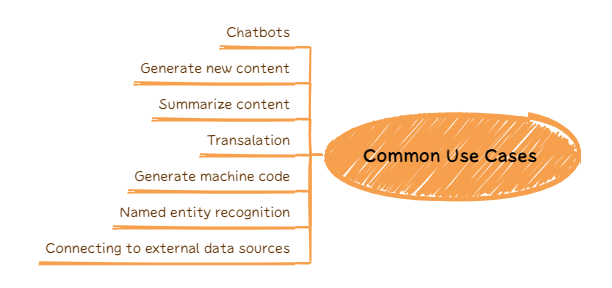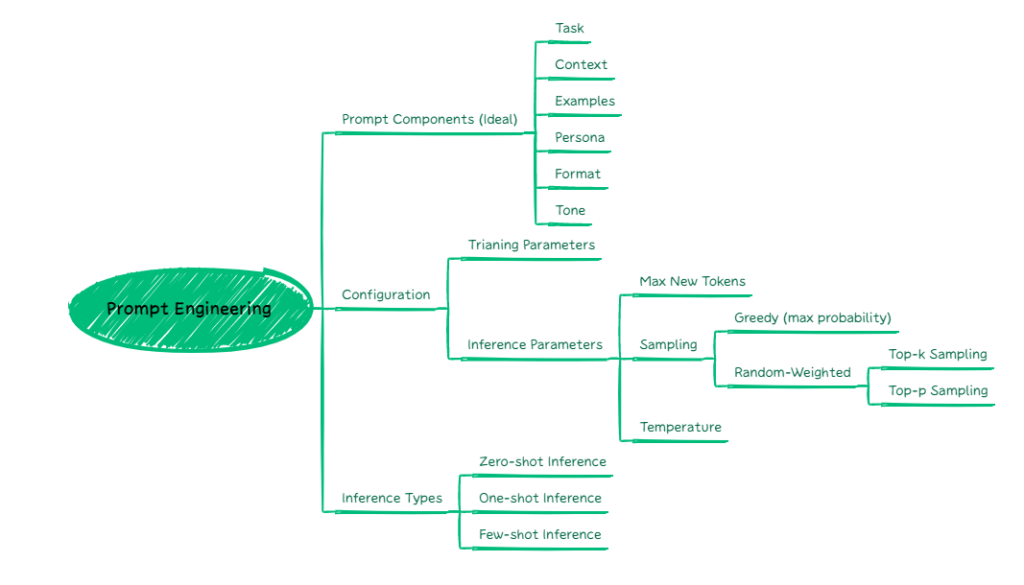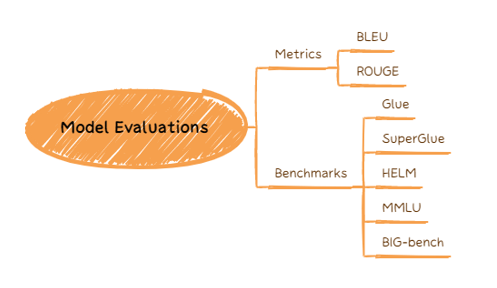While the advent of ChatGPT has garnered significant attention in the Technology world, Generative AI extends far beyond this celebrated model. I recently took the course “Generative AI with Large Language Models” from DeepLearning.AI and AWS helped me to unravel its core principles and practical applications that have the potential to reshape the landscape of technology and innovation.
Generative AI, a subfield of artificial intelligence, focuses on creating intelligent machines capable of producing content, be it text, images, or other forms of data, that is indistinguishable from what a human might generate. It harnesses the power of large language models and deep learning techniques to produce creative, contextually relevant outputs that hold immense promise in various industries.
Here are my key learnings from this course in the form of mind maps. I will be writing explicit posts on each of the below headers with examples later.
Transformer Architecture
The transformer architecture has revolutionized the field of natural language processing (NLP) and is now widely used in a variety of NLP tasks.

Model Types:
- Encoder-only models are pre-trained with Masked Language Modeling (MLM) and have the same tokens for input and output. They are bidirectional and Autoencoding models. Examples of autoencoding models include BERT and ROBERTA. These models are commonly used for tasks like sentiment analysis, named entity recognition, and word classification.
- Decoder-only models are pre-trained using Causal Language Modeling (CLM) and are unidirectional. They are Autoregressive models. An example of an autoregressive model is GPT. These models are typically used for text generation and zero-shot inferences.
- Encoder-decoder models are sequence-to-sequence models that can be used for tasks like translation, text summarization, and question answering. Examples of encoder-decoder models include T5 and BART.
Common Generative AI Use Cases
Some of the common use cases for which Generative AI is being currently used are listed below.
- Chatbots
- Generate new content
- Summarize content
- Translation
- Generate code
- Named entity recognition
- Connecting to real-time data or external data sources

Base Gen AI Models
There are plenty of new large language models becoming available every day but these are the basic models out there right now (October 2023).
- GPT
- FLAN-T5
- PaLM
- LLaMa
- BERT
- BLOOM

The two most popular model hubs available currently are
- Hugging Face
- PyTorch
Becoming Better at Prompts: Prompt Engineering
Prompt engineering plays a pivotal role in the effectiveness and precision of natural language processing models, particularly in applications involving text generation and completion. It involves carefully crafting the input or instruction given to the model to generate desired and contextually appropriate responses. The importance of prompt engineering cannot be overstated.

Challenges with Gen AI
Major current challenges with respect to using Generative AI are
- Computational (Hardware and Memory)
- Fine-tuning models
- Others
- Missing latest data
- Mathematical problems
- Hallucination

Gen AI Project Lifecycle
Below are the four key stages of a generative AI project lifecycle:
1. Scope
- Clearly define the problem or use case for which the generative AI model will be applied.
- Understand the specific requirements and expectations for the model’s performance.
2. Select
- Determine whether to utilize an existing pre-trained generative AI model or develop a new one from scratch.
- Consider the suitability of the model’s capabilities and limitations for the intended use case.
3. Adapt and Align
- Employ prompt engineering techniques to refine the model’s prompts and instructions for generating desired outputs.
- Fine-tune the model’s parameters and training data to enhance its performance and alignment with the specific task.
- Incorporate human feedback to continuously improve the model’s accuracy and relevance.
4. Deploy
- Optimize the model for efficient inference and deployment in real-world applications.
- Integrate the model into existing applications or develop new generative AI-powered applications.
- Augment the model’s capabilities by combining it with other AI techniques and tools.

How to evaluate Gen AI Models?
The two widely used metrics to evaluate Gen AI models are
- BLEU (Bilingual Evaluation Understudy)
- ROUGE (Recall-Oriented Understudy for Gisting Evaluation).

Optimize Models: Reinforcement Learning from Human Feedback (RLHF)
Reinforcement Learning from Human Feedback (RLHF) is a transformative approach in the field of Generative AI that combines the strengths of human expertise with machine learning algorithms to enhance the capabilities of AI models like GPT-3. This technique aims to bridge the gap between AI’s understanding of human preferences and the ability to generate content that aligns more closely with those preferences.
Key Principles of RLHF:
- Feedback Loop: RLHF establishes a feedback loop where human evaluators provide ratings or feedback on model-generated content. This feedback loop is essential for the model to learn from human preferences and improve its performance.
- Reward Models: Reward models are created based on the human feedback. These models serve as guides for reinforcement learning, helping the AI model understand what kind of content is considered more desirable or accurate by humans.
- Training and Fine-Tuning: The AI model is then retrained and fine-tuned using reinforcement learning techniques. It is exposed to various prompts and content generation tasks to improve its performance in line with the provided feedback.

Responsible AI
It is a fundamental concept in the ongoing quest to ensure that AI technologies benefit society while minimizing potential harm. Responsible AI goes beyond just creating intelligent machines; it places a significant emphasis on the ethical, social, and legal considerations that surround AI.
The three areas to primarily focus are
- Toxicity
- Hallucinations
- Intellectual Property Rights Violations

If you found this interesting, you can find more such articles here on quality assurance, test automation, tools, and processes. Don’t forget to leave your comments here or on Twitter @testingchief. Thank you!











